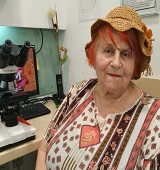
Vuka V Katic
Human Policlinic, Serbia
Title: Giant inflammatory myofibroblastic tumor of the breast case report and review of literature
Biography
Biography: Vuka V Katic
Abstract
Introduction: Primary inflammatory myofibroblastic tumor ( IMT ) of the breast is extremely rare lesion. Only 19 cases have been reported in the English literature. It is an unusual benign tumor that belongs to the family of the " benign spindle cell tumors of the of the mammary". Since MFT ( myofibroblastic tumor ) may show alarming morphologic features which can lead to misdiagnosis of malignancy, especially to spindle cell carcinoma, we have undertaken this study:
Case report: Clinical features and aim We report a case of IMT of the breast in a 56- year - old female patient who was admitted to our hospital due to a large lobulated lump in the right breast. Mammogram and ultrasound confirmed the solid nature of the tumor, showing a well- circumscribed homogenous mobile nontender lobulated masses, covered by thick capsula.The giant tumor, was surgically removed.
MacroscopyThe giant tumor, 8200 gr of weight, was surgically removed. Gros examination showed a well circumscribed firm white, yellow to grey lobular masses ( Fig. 1 ). After conservative excision, has been no recurrence to now ( two years have passed from operation ).
Methods: 50 surgical biopsies, taken from our patient,were stained with HE, Van Gieson, AB - PAS and immunohistochemical ABM, by using antiboodies to EMA, Vimentin, Demin and Ki-67.
Histopathology The lesion consists of a proliferation of spindle cells with the morphological and immunohistochemical features of myofibroblasts, arranged in sheets and short fascicles along with a rich inflammatory infiltrate comprising predominantly plasma cells, admixed with the an inflammatory component of lymphocytes, and eosinophyls. The hallmark of IMT is the sgnificant inflammtory cell component. Mitotic figures were not observed. Histopathologically, the tumor cells were positive for SM-actin, desmin and vimentin.
Conclusion: On the base of literature data ( Pab Med )and our experience, We have concluded the following:
I. This neoplasm has the intermediate biological potential. II. Like neoplasm of intermediate biological potentia it frequently recurs and rarely metastasizesIII.Clinical physicians should regularly follow - up patients after focal resection for IMT

